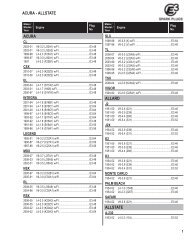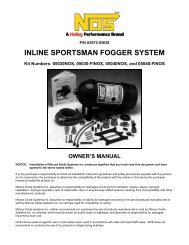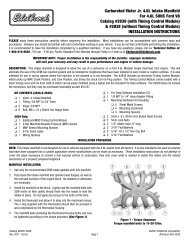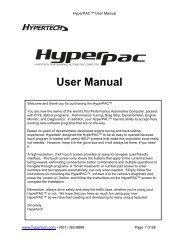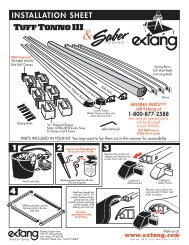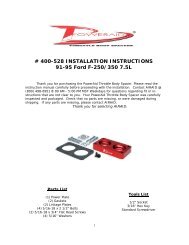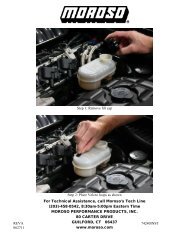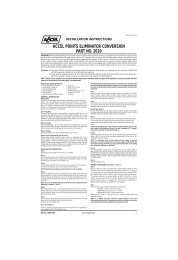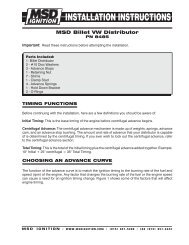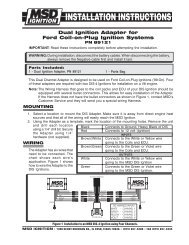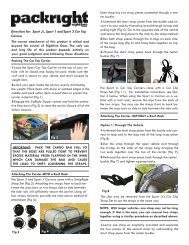Edelbrock 70055 Nitrous System Installation Instructions - Jegs
Edelbrock 70055 Nitrous System Installation Instructions - Jegs
Edelbrock 70055 Nitrous System Installation Instructions - Jegs
You also want an ePaper? Increase the reach of your titles
YUMPU automatically turns print PDFs into web optimized ePapers that Google loves.
2.11.1 <strong>Nitrous</strong> Electrical <strong>System</strong> <strong>Installation</strong> Procedures<br />
Determine the location of the Relay and Fuse Holder wire harness. Most common installations<br />
locate these components inside the driver’s compartment and close to the fuse panel under the<br />
dash. You can also mount the Relay and Fuse Holder and harness close to the battery. However,<br />
these connectors are water-resistant not waterproof, so care is required when mounting this<br />
assembly under the hood of your vehicle.<br />
Wire Schematic Origin and Destination Map<br />
Wire Color <strong>System</strong> Origin Destination Terminal Used<br />
Red Bat Voltage Relay Harness Bat. Volt. Signal Ring<br />
Red Arming Switch Underdash Switched 12v Spade/Wire Intercept<br />
Black Relay Ground Relay Harness Chassis Ground Ring<br />
Black Solenoid Ground Solenoids Chassis Ground Ring<br />
Black Arming Switch Grnd. Arming Switch Chassis Ground Ring<br />
Blue Solenoid Power Relay Harness Solenoids Spade<br />
White Microswitch Relay Harness Microswitch Spade<br />
White Microswitch Arming Switch Microswitch Spade<br />
2.12 <strong>Nitrous</strong> Relay and Fuse Holder <strong>Installation</strong><br />
The wire harness attached to the relay and fuse holder includes 8 feet of color-coded wires to make the<br />
electrical system installation for your <strong>Edelbrock</strong> <strong>Nitrous</strong> <strong>System</strong> as easy as possible. We recommend that<br />
you do not cut any lengths of wires from the wire harness or complete the wiring of the nitrous system until<br />
all of the mechanical components are securely mounted in their permanent locations.<br />
Once all of the solenoids and switches are placed, then route the un-cut wires from the harness to each<br />
location allowing enough wire length on each circuit to not interfere with operating linkages, heat sources,<br />
brackets, etc. Pay particular attention to sharp edges along the route of your wire harness as they can<br />
chafe the wire and cause your system to fail.<br />
After you have accounted for the routing of your wires, follow the Wire Harness Schematic and use the<br />
Origin and Destination Map as a guide for which electrical connectors are used in each circuit.<br />
Once you have decided the location of the relay and fuse holder, secure them with fasteners (not included<br />
with kit) such as sheet metal screws, bolts and nuts, etc. Allow for some slack in the red wire that connects<br />
the relay and fuse holders together.<br />
When mounting your relay and fuse holder, make sure the mounting surface is strong enough to support<br />
servicing the relay and fuse. Also, ensure you allow for some slack in the wire that joins the fuse holder<br />
to the relay mount. This will avoid any potential loss of power due to stress on the wire harness.<br />
The fuse is covered by the fuse mount housing.<br />
The relay for the Performer system is 30 amps, and the fuse is 15 amps.<br />
Catalog #<strong>70055</strong> & #70056<br />
Brochure No. 63-0060<br />
Page 18 of 26<br />
©2002 <strong>Edelbrock</strong> Corporation<br />
Rev. 3/02



